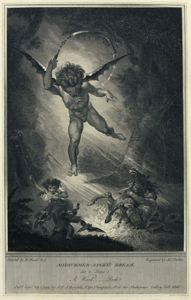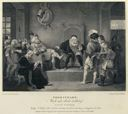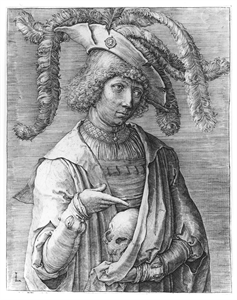
John Boydell
English, 1719–1804
Josiah Boydell (aka Joshua Boydell)
English, 1752–1817
James Parker
English, 1750–1805
after Henry Fuseli
Swiss, 1741–1825
From Boydell's Graphic Illustrations of the Dramatic Works of Shakespeare
In 1786, a successful London publisher, alderman John Boydell, conceived of a gallery of art devoted to scenes from Shakespeare’s plays. Named for its founder, the Boydell Shakespeare Gallery was one of the first large-scale commercial endeavors intended to promote British literature and artists both in Great Britain as well as throughout the European continent. He commissioned over 167 paintings of scenes from Shakespeare’s plays and produced engravings based on these paintings. In creating the engravings, John Boydell partnered with his son, Josiah, whose name appears after his father’s in the list above. The third name is that of the engraver, and the fourth is that of the painter who created the original composition in oils. The role of the engraver was to transfer the painter’s composition onto plates for printing.
About this scene:
Shakespeare emerges from producing history plays and the early 1590s plague's closures of theaters in a more lyrical vein, and figures of mayhem now foster laughter in his comedies—here with one who scrambles young lovers’ affections and improvises transformations, an English folklore character called Puck, now impish attendant to Oberon, king of the fairies.
Puck’s antics traditionally include shape-shifting and trickery, as with travelers led astray or the mischief Titania’s fairies guard against [both shown below]. Yet Puck dominates here, bearing the love-inducing flower, so that when fleeing lovers and Athenian workmen show up in the fairy-filled wood this night, affections conflict and confusions ensue in the play’s dreamlike scenario. The pairs of lovers mismatch under the flower’s spell, and the flower-drugged Fairy Queen falls for now-ass-headed Bottom the weaver, all changes aided or mistaken by Puck, who carries us through love’s restorations to the play’s benedictory Epilogue.
-Susan Willis, dramaturg, Alabama Shakespeare Festival, September 28, 2020
English, 1719–1804
Josiah Boydell (aka Joshua Boydell)
English, 1752–1817
James Parker
English, 1750–1805
after Henry Fuseli
Swiss, 1741–1825
Midsummer-Night’s Dream, Act 2, Scene 1
about 1804From Boydell's Graphic Illustrations of the Dramatic Works of Shakespeare
Object Type:
Print
Dimensions:
10 3/16 x 6 7/16 in. (26 x 16 cm)
Medium and Support:
Engraving on paper
Accession Number:
2016.0008.0004
Credit Line:
Montgomery Museum of Fine Arts Association Purchase and Gift of Francis Drexel Smith, by exchange
In 1786, a successful London publisher, alderman John Boydell, conceived of a gallery of art devoted to scenes from Shakespeare’s plays. Named for its founder, the Boydell Shakespeare Gallery was one of the first large-scale commercial endeavors intended to promote British literature and artists both in Great Britain as well as throughout the European continent. He commissioned over 167 paintings of scenes from Shakespeare’s plays and produced engravings based on these paintings. In creating the engravings, John Boydell partnered with his son, Josiah, whose name appears after his father’s in the list above. The third name is that of the engraver, and the fourth is that of the painter who created the original composition in oils. The role of the engraver was to transfer the painter’s composition onto plates for printing.
About this scene:
Shakespeare emerges from producing history plays and the early 1590s plague's closures of theaters in a more lyrical vein, and figures of mayhem now foster laughter in his comedies—here with one who scrambles young lovers’ affections and improvises transformations, an English folklore character called Puck, now impish attendant to Oberon, king of the fairies.
Puck’s antics traditionally include shape-shifting and trickery, as with travelers led astray or the mischief Titania’s fairies guard against [both shown below]. Yet Puck dominates here, bearing the love-inducing flower, so that when fleeing lovers and Athenian workmen show up in the fairy-filled wood this night, affections conflict and confusions ensue in the play’s dreamlike scenario. The pairs of lovers mismatch under the flower’s spell, and the flower-drugged Fairy Queen falls for now-ass-headed Bottom the weaver, all changes aided or mistaken by Puck, who carries us through love’s restorations to the play’s benedictory Epilogue.
-Susan Willis, dramaturg, Alabama Shakespeare Festival, September 28, 2020
Keywords
Click a term to view the records with the same keyword
Related Objects
Click a record to view

Tempest, Act 1, Scene 2
2016.0008.0001

Merry Wives of Windsor, Act 5, Scene 5
2016.0008.0002

Much Ado About Nothing, Act 4, Scene 2
2016.0008.0003

Merchant of Venice, Act 3, Scene 2
2016.0008.0005

Taming of the Shrew, Act 4, Scene 5
2016.0008.0006

Twelfth Night, Act 2, Scene 3
2016.0008.0007

Macbeth, Act 1, Scene 3
2016.0008.0008

Macbeth, Act 5, Scene 1
2016.0008.0009

King Richard II, Act 3, Scene 2
2016.0008.0010

King Henry IV, Part 1, Act 2, Scene 1
2016.0008.0011

King Henry V, Act 3, Scene 3
2016.0008.0012

King Henry VI, Part 1, Act 5, Scene 4
2016.0008.0013

King Richard III, Act 3, Scene 1
2016.0008.0014

Antony and Cleopatra, Act 4, Scene 4
2016.0008.0015

Romeo and Juliet, Act 3, Scene 5
2016.0009.0001

Hamlet, Act 3, Scene 4
2016.0009.0002

Hamlet, Act 4, Scene 7
2016.0009.0003
Portfolio List
Click a portfolio name to view all the objects in that portfolio
This object is a member of the following portfolios:
Your current search criteria is: Portfolio is "Classification: Print" and [Object]Display Artist is "John Boydell".
